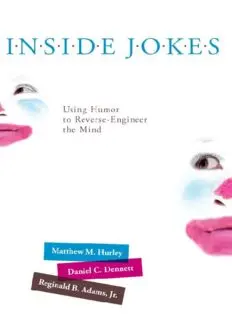Table Of Content
Inside Jokes
Inside Jokes
Using Humor to Reverse-Engineer the Mind
Matthew M. Hurley, Daniel C. Dennett, and Reginald B. Adams, Jr.
The MIT Press
Cambridge, Massachusetts
London, England
© 2011 M assachusetts Institute of Technology
All rights reserved. No part of this book may be reproduced in any form by any
electronic or mechanical means (including photocopying, recording, or information
storage and retrieval) without permission in writing from the publisher.
For information about special quantity discounts, please email special_sales
@mitpress.mit.edu
This book was set in Stone Sans and Stone Serif by Toppan Best-set Premedia Limited.
Printed and bound in the United States of America.
Library of Congress Cataloging-in-Publication Data
Hurley, Matthew M., 1977– .
Inside jokes: using humor to reverse-engineer the mind / Matthew M. Hurley,
Daniel C. Dennett, and Reginald B. Adams.
p. cm.
Includes bibliographical references and index.
ISBN 978-0-262-01582-0 (hardcover: alk. paper)
1. Laughter— Psychological aspects. 2. Laughter— Philosophy. 3. Wit and humor—
Psychological aspects. 4. Wit and humor— Philosophy. I. Dennett, Daniel
Clement. II. Adams, Reginald B. III. Title.
BF575.L3H89 2011
152.4′ 3 — dc22
2010044707
10 9 8 7 6 5 4 3 2 1
Contents
Preface ix
1 Introduction 1
2 What Is Humor For? 9
3 The Phenomenology of Humor 15
A. Humor as a Property of Objects or Events 16
B. D uchenne Laughter 19
C. The Systematic Ineffability of Humor 24
D. Funny-Ha-Ha and Funny-Huh 27
E. T he Knowledge-Relativity of Humor 31
F. Mating and Dating 34
4 A Brief History of Humor Theories 37
A. Biological Theories 37
B. P lay Theories 38
C. Superiority Theories 40
D. Release Theories 44
E. Incongruity and Incongruity-Resolution Theories 45
F. Surprise Theories 53
G. B ergson’ s Mechanical Humor Theory 54
5 Twenty Questions for a Cognitive and Evolutionary Theory of
Humor 57
6 Emotion and Computation 61
A. Finding the Funny Bone 61
B. Does Logic or Emotion Organize Our Brains? 63
C. Emotions 67
D. The Rationality of Emotions 73
E. The Irrationality of Emotions 80
vi Contents
F. Emotional Algorithms 83
G. A Few Implications 89
7 A Mind That Can Sustain Humor 93
A. Fast Thinking: The Costs and Benefi ts of Quick-Wittedness 93
B. T he Construction of Mental Spaces 95
C. Active Beliefs 104
D. Epistemic Caution and Commitment 109
E. Confl ict; and Resolution 112
8 Humor and Mirth 117
A. The Contamination of Mental Spaces 117
B. Mirth among the Epistemic Emotions: The Microdynamics 122
C. Rewards for a Dirty Job Well Done 127
D. “ Getting It ” : Basic Humor in Slow Motion 130
E. Interfering Emotions 139
9 Higher-Order Humor 143
A. The Intentional Stance 143
B. The Difference between the First Person and the Third Person 148
C. Anthropomorphism and Anthropocentrism 155
D. Intentional Stance Jokes 157
10 Objections Considered 177
A. Falsifi ability 177
B. Epistemic Undecidability 182
C. Apparent Counterexamples 187
D. A Brief Glance at Others’ Models 201
E. G raeme Ritchie’ s Five Questions 208
11 The Penumbra: Nonjokes, Bad Jokes, and Near-Humor 213
A. Knowledge-Relativity 214
B. S cale of Intensity 216
C. Boundary Cases 220
D. Wit and Other Related Phenomena 246
E. Huron on the Manipulation of Expectations 250
12 But Why Do We Laugh? 257
A. Laughter as Communication 257
B. C o-opting Humor and Laughter 264
C. The Art of Comedy 270
D. Comedy (and Tragedy) in Literature 278
E. Humor That Heals 283
Contents vii
13 The Punch Line 287
A. Twenty Questions Answered 289
B. Could We Make a Robot with a Sense of Humor? 296
Epilogue 301
References 305
Index 329
Preface
In April 1975, Martin Gardner reported, in his S cientifi c American magazine
column “ Mathematical Games,” that a new computer chess program
invented at MIT “ had established, with a high degree of probability, that
pawn to king ’ s rook 4 is a win for White. ” Tragedy! If this were so, the
noble game of chess would be killed for all time, no more challenging than
tic-tac-toe. Even if the algorithm purportedly discovered by the program
was tediously complicated, something no human chess-player could hope
to memorize, the mere knowledge that there was a mindless recipe for
winning any game of chess would drain all the glory, all the art, out of the
contest. Who would want to devote years to honing skills, enduring gruel-
ing tournaments, hunting for exquisite new strategies, all the while
knowing that there was an easier way to win, a cheap trick that could not
be thwarted? Nobody knows how many readers were taken in, but surely
Gardner’ s unwelcome news struck at least momentary dread in the hearts
of some chess-lovers, before they tumbled to the date and chuckled with
relief. April Fools ’!
Late one night a few years later, the sex researchers William Masters
and Virginia Johnson, authors of Human Sexual Response (1966), were
analyzing their voluminous data on orgasm and noticed a subtle but
striking pattern: they had discovered, to their amazement, that the uttering
of a simple verbal formula, a string of words (in any language) that exhib-
ited an arcane pattern based on the Fibonacci series, would bring any
normal postpubescent human to orgasm within a minute. They rechecked
their data, ran just a few confi rmatory experiments, and then . . . destroyed
their notes, salted their data with misleading falsehoods to conceal the
pattern from future eyes, and took a solemn vow not to reveal the secret
they had uncovered. Thanks to their heroic sacrifi ce, sex as we know it
lives on.

